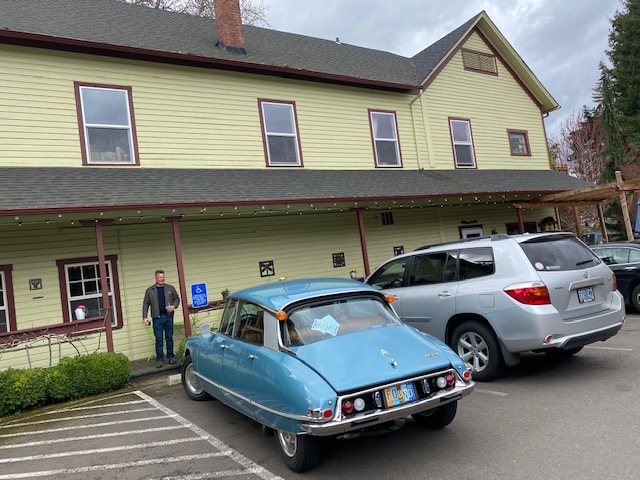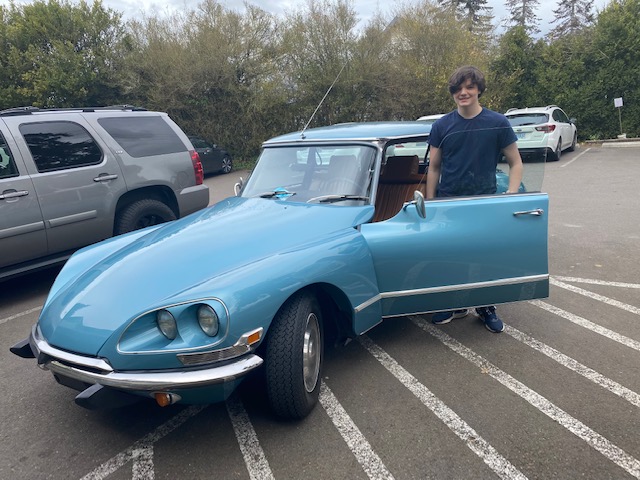Three things came together this weekend to let me exercise two SCM cars.
First, the weather was perfect. Well, perfect for Oregon in March: Overcast, about 50 degrees and occasional light sprinkles in the forecast.
Second, both the 1971 Jaguar V12 2+2 and the 1971 Citroën DS21 Pallas were in fine fettle.
Third, as my 14-year-old son Bradley gets closer to his 15th birthday this May, the reality of having a permit has made him an easy road-trip partner.
It’s no secret that I’ve had more than my share of “Flatbed Follies” over the past couple of years.
I understand why. When you put a formerly somnambulant 50-year-old car into daily use, stuff breaks. Little stuff like float needles, rotors, points, etc. Cars dislike sitting, and waking them up can be a frustrating process. However, as these are analog cars, it generally comes down to air, fuel and spark.
My two most dissimilar cars are the Citroën and the Jaguar.
The Citroën is powered by a 2.2-liter inline pushrod 4-cylinder. The engine is really an afterthought compared to the fabulous styling and the unusual suspension that substitutes nitrogen-filled spheres for shock absorbers. In addition, the car has a tall greenhouse and unusually large amounts of room for front and rear passengers. It is light and airy. Everyone wants to go for a ride in it.
In contrast, the Jaguar is all about the engine. It has a magnificent 5.3-liter V12, with four Zenith-Stromberg carburetors. In 1971, it produced 272 horsepower. To me the styling is a little contrived, and not nearly so clean as the 6-cylinder cars. Despite the exterior being larger, the interior feels to be the same size as that of the 6-cylinder cars. This means it’s a tight fit in the front, and the backseat is only good for small dogs or large guinea pigs.
Bradley likes both cars. While at first he thought the Citroën “looked like a dead fish,” he enjoys the attention we get wherever we go. And his friends all think it is pretty cool looking, which is a plus.
We took the DS out first. This was his first time starting it. He pulled out the choke, gave the gas pedal a couple of pumps, turned on the key and looked expectantly at me when nothing happened.
I explained that with the semi-automatic BVH transmission you had to move the shifting wand all the way to the left, and it will engage the starter. And it did!
He has learned how to nurse a cold, choke-engaged engine to life. I slid behind the wheel, and we waited for the car to raise up to its normal height and set off on our adventure.
Ever since we had a sticking needle valve cause us to come to a halt on the freeway, I have started putting non-ethanol (“clear”) gas in my classics. It may be my imagination, but they seem to start and run better.
Our destination was a quaint cafe in Hillsboro, OR, about 20 miles away. The South Store Café is a rarity – a non-chain restaurant that actually makes everything they sell from scratch.
I had been introduced to the cafe the day before by SCMer Steve Hunker (who owns a supercharged Lotus Elise and a pair of Miata race cars, plus others). We had also driven out there in the Citroën.
Steve is a thoughtful driver, and I enjoyed watching him master the semi-automatic gearbox. It requires a perfect hand and foot ballet of backing off the gas, shifting, then giving it gas as you feel the gears engage. He was quite good at it.
Bradley and I had a good lunch. I drove the 20 miles home without stalling once. I even managed to shift between 1st and 2nd fairly successfully. While not quick by any means, the Citroën is able to cruise easily at 70 mph.
I do enjoy this car. It requires that you pay constant attention, and I like that.
We topped off the tank with clear gas (at $7 a gallon) and put the car away at Pro-Tek Automotive.
Next week, we’ll talk about the second car we drove, and compare and contrast it with the DS.





3 responses to “Keith’s Blog: 109 vs. 272”
Back in the late 1960s our neighbor had a Citroën DS, not sure what year exactly. It was by far the most exotic car in our modest middle class neighborhood. He gave my Dad, Brother and I a ride in it once and I remember thinking how odd it seemed compared to any of the Fords we had. It felt like sitting on your comfy couch and floating down the road on a cushion of air. I’m with Bradley on the styling, it always looked catfish or carp like to me.😆
Here “clear gas” is labeled “non-oxygenated or non-oxy” for short. In MN our fun cars are stored for 5-6 months so fuel that is stable is essential to maintaining fuel system integrity. Ethanol deteriorates quickly rendering vulnerable components compromised. I use it for my mower, snowblower, motorcycle for the same reason. It is my experience that “clear, non-oxy” does help an engine run better; Most dramatically, for me, in the Harley.
Hey Keith,
Are you referring to “non-ethanol fuel” needed for most 2 cycle engines and recommended for most American cars built prior to 1973?